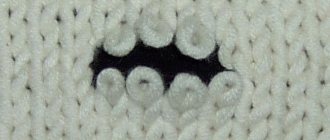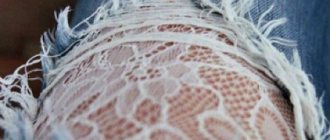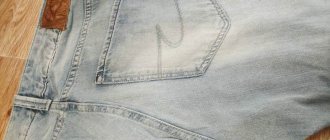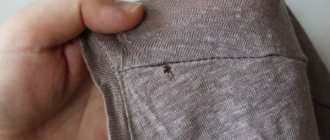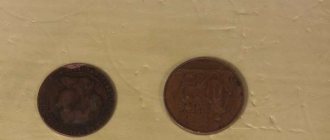Recommendations on how to sew jeans between your legs discreetly
Even thick denim pants can rip in the most inopportune places. And if holes in the knees look familiar, then things worn between the legs are usually either thrown away or mended. Matter often becomes thinner due to its dilapidation: sooner or later abrasions will appear on it.
How to sew up a hole in jeans? Craftswomen do not advise getting rid of them, because you can repair a hole in just half an hour. The publication contains tips on how to sew jeans between your legs unnoticed, both by machine and by hand.
Some useful tips
It is worth listening to the advice of experienced housewives:
- Be sure to turn the item inside out when you plan to sew it up. The front side of the item must be made perfectly, with invisible seams and knots.
- A seam ripper will be a great help when removing unnecessary stitches.
- Store needles correctly. They should be stuck into a pad or paper.
- Try to work on your own mistakes, because the first attempt may not always be successful.
- The thread should always be matched.
- Be sure to finish the work with the correct stitches, because if you leave the thread and do not fix it in any way at the end, the seam will simply fall apart.
If you are very worried and afraid to sew up the item yourself, then it is better to contact a tailor shop that will readily solve all problems with torn clothing.
What you need for work
For hand sewing you need the following materials and tools:
Seamstresses advise working with household needles, which are sold in a set. To sew up a hole without a sewing machine, use numbers 11 and 14. The threads are also chosen thicker.
Cotton threads from 50 to 80 numbers or from 50 to 60 numbers (synthetics) are suitable. You can also use a sewing machine to repair a hole in your pants.
Preparing for work
Everyone always has a needle and at least three threads of primary colors: black, white and red. In order to sew up a hole really neatly, you must learn how to sew up a frayed element on clothing aesthetically, beautifully and without visible seams. Of course, it is difficult to deal with large holes, trying to make them completely unnoticeable, but if you try, you should definitely be able to sew them up efficiently.
Before sewing, first pay attention to the size of the hole, the edges, and how frayed this area of the clothing is.
General recommendations
Clothes are darned so that it looks neat and unnoticeable. Large holes are patched, and light abrasions are corrected using the plastering method. But not everyone knows how to do it correctly.
It is recommended to remove protruding threads, as they will spoil the appearance of the stitching on the fabric. The darning is done from the wrong side so that each seam looks beautiful. When the material is stitched, it is ironed.
Patches
The matter will stop unraveling if you put a patch on the wrong side. Craftswomen cut a piece of fabric of the same shade (the material of any old denim item will be useful). A couple of horizontal cuts are made on it, which will be identical in size to the hole.
Afterwards, the seamstress carefully pulls out the longitudinal threads. When the holes match, step back a centimeter from each side and cut out a patch. Then the workpiece is placed under the abrasion and sewn with small stitches. In this case, the color of the thread is selected to match the denim.
Standard Patches
How to quietly sew up a hole in jeans? To do this, ordinary fabric patches are placed on top of the worn material. You can cut out a fabric square, attach it, iron it and secure it with pins. In this case, there should be a centimeter left for the hem on each side.
Then the part should be ironed, bending the edges and secured to the jeans. This method can be difficult to apply if the trouser leg is torn in hard-to-reach places. Sometimes seamstresses rip out factory stitches to better secure patches.
Replacing the damaged area
To sew up jeans discreetly by hand, craftsmen completely replace the torn part of the item, maintaining symmetry. To work, you will need 2 shades of thread: to match the color of the fabric and threads whose color matches the factory ones.
How to sew clothes correctly:
- To begin with, the back and side seams of the pants are partially ripped out.
- Then cut out the rubbed part.
- Then the fabric for replacement is cut out. However, its shape must be identical.
- The cut out part is applied to the prepared scraps and identical blanks are cut out.
- Next, all the flaps are basted and sewn in so that the patch on the pants looks neat.
In order for the item to retain its appearance for a long time, the sections for the inserts are cut out in such a way that the guide threads are located diagonally. This way the material will stretch well.
Seamstresses use not only denim or stretch fabrics, but thick corduroy or leather inserts. They will look more harmonious if there is a patch on the legs, and not just in the crotch area. It is cut from the same material.
Features of repair of various types of pants
Classic pants
In suit trousers, you should sew up a rip only if it is not visible. If the sewn place is visible to others, this will clearly damage the business reputation of their owner.
Seam divergence is very easy to fix. To do this, use a machine or a needle if the hole is small, using threads to match the fabric on the wrong side. It is better to sew up a small hole in an inconspicuous place with a needle. It is necessary to ensure that the sewn area does not gather: do not tighten the thread, straighten the fabric in the process.
You can significantly extend the service life of trousers:
- first of all, you need to monitor the serviceability of the braid, which, as a rule, is trimmed from the inside of the bottom of the trousers;
- as soon as the braid begins to fray, it must be replaced with a new one so that “fringe” does not appear on the trousers;
- The braid must be sewn so that its thick edge protrudes 1 mm from under the trouser cuff.
So-called cuffs are often made on trousers. If they are frayed, you need to completely tear them apart, clean them with a damp stiff brush, iron them through a wet cloth and plaster them (see the “Plastering” tip). The width of the cuff is usually 5 - 6 cm. When sewing, it will decrease slightly. Accordingly, the trousers themselves will become somewhat shorter. Therefore, the new line of the cuff should be 1 - 2 mm higher than the previous one, then it will cover the place of the piece.
To prevent trousers from stretching at the knees, it is recommended to sew twill, silk, half-silk or other slip fabric from the inside. Thanks to this, the trousers stretch much less at the bends of the knees and retain the fold much longer.
Jeans
These are the most popular pants of all time. Jeans are worn by adults and children, men and women, old people and youth. Modern fashion allows you to leave a hole or abrasion on your jeans unchanged. Contrasting or matching patches look great on such clothes. This gives the clothes individuality. Still, there are such damages that the jeans will have to be sewn up.
- From a piece of denim fabric of similar color, cut out a square, the size of which is 2 cm larger than the hole. If the fabric around the hole has become too weak (rotten), we put a larger patch.
- We select threads to match the denim fabric. This stage is the most important. It depends on him whether the darning will be visible. When going to the store for threads, do not forget to take with you the jeans that need to be hemmed. After all, there are countless shades of denim (denim).
- From the wrong side, we place the cut flap on the hole, secure it with pins and sew around the perimeter with a basting stitch. When the patch is securely fixed, remove the pins.
- Place the jeans under the paw with the hole facing up. You need to darn jeans by running stitches on the machine from one edge of the basting seam to the other and back. To perform a reverse stitch, you do not need to turn the jeans over under the presser foot; just use the reverse stitch. We pull the fabric to the side when sewing so that the stitch does not lie on the stitch, but goes in a zigzag.
- Remove the fringe from the surface of the hole.
The trousers are sewn. Now the old hole is invisible. Holes on the knees can also be darned in a similar way, and fabric can be placed in a contrasting or patterned one.
Jeans often fray between the legs. It’s impossible to beat this - you need to fix it, because soon a hole will form there. You need to take a cotton piece of fabric the width of the abrasion. Attach it from the wrong side and darn with suitable threads, which will be invisible from the front side. Thus, the life of the trousers is extended and holes are prevented.
A large hole with jagged edges is best repaired with a patch. The patch is chosen from the same material, but companion fabric can also be used. The patch can be attached in two ways:
- on the front side - the edges of the patch are folded, sewn over the hole, then stitched with decorative stitching (optional);
- from the wrong side - the patch is attached from the wrong side, leaving the hole open, then the edges are fluffed up (this technique looks impressive on denim clothes).
Repairing jeans may sometimes simply be beyond your ability if, for example, you don’t have a good sewing machine or don’t have enough experience. And after an unsuccessful attempt to sew up your jeans, you will throw them into the back drawer of the closet, or even throw them away altogether. However, any jeans can easily be turned into shorts. It’s enough just to cut the legs evenly and correctly with scissors and pull out a few transverse threads along the edges to get these original denim shorts. Buy about a hundred of these metal jewelry and “breathe” new life into your old, torn jeans.
Not only shorts can be made from jeans. You can make a very original bag from old jeans. Denim pieces can be used to combine with other fabrics such as leather. Eventually, the remaining pieces of jeans without holes can be used to repair other jeans.
Children's trousers
Holes can appear in children's trousers at unexpected times. All of the above methods are suitable for repair. In addition, you can now purchase adhesive-based patches of various sizes in craft stores. They are easily and quickly attached to the fabric using an iron. Withstands numerous washes. In addition, they depict various children's drawings, cartoon characters, and funny inscriptions.
On the front side you can select and sew a piece of fabric with a picture, applique or emblem:
- Place the pants on the work table with the hole facing up. From the lining fabric, cut out a rectangle approximately 1-3 cm larger than the hole.
- We apply the material from the wrong side and collect the torn edges, securing them with needles. It is better to carefully mend the tear from the front side.
- Now attach the emblem of your choice with needles to the front part (so that it does not move) and sew it along the edge.
The most interesting holes will be those resulting from accidental “trauma” - with torn edges and even torn out pieces of material. This is a great opportunity to show your imagination and update them. You can make patches in these places using the method described above from a similar or, conversely, contrasting fabric. Some applique made from multi-colored pieces of fabric will look even more fun and interesting.
How to sew knitted pants
The industry has given us such an amazing fabric as knitwear. Knitted items have settled firmly and for a long time in closets. After all, they are comfortable and pleasant to wear. Almost everyone has a pair of knit sweatpants that sometimes need mending.
When sewing holes on such a product, it is important to follow each eyelet along the edges of the hole. It is necessary to pick up each one with a needle and tighten it with thread. If you miss at least one, it will subsequently form arrows. This spoils the appearance of the item and makes it unwearable.
When repairing knitted trousers, it is appropriate to use any fabric adhesive. For example, non-woven fabric or dublerin. Turn the pants inside out, align the edges of the hole evenly, cut out a piece of glue (slightly larger than the hole) and go over it with a hot iron.
Repair without patches
How to sew up a hole in jeans beautifully? There are several ways for which you do not need to make patches. They are simple to perform, and if you learn how to do it, you can quickly and easily restore worn-out material.
Darning by hand
How to mend a hole in jeans? With this method of repairing things, frayed threads are replaced with new ones. To do this, darn along the worn area.
If there are factory threads left on the fabric, then pass the needle first under and then over them.
When the row ends, a needle is threaded from the end through several threads on a whole piece of material. At the same time, the gaps from the edges of the torn material should remain minimal, but should fix the fabric well. This way, the darned area will be less noticeable, and the denim will stop unraveling.
Usually craftsmen do a continuous stitch: this way the darning will be dense and more durable. Then they continue to mend the hole, but not along, but across. First, the needle is passed under the thread, which is located perpendicularly, then over all the following ones. The seamstresses make sure that the stitching is tight and there are no gaps. If this condition is met, and the color is matched tone to tone, then the repair will be barely noticeable.
How to mend jeans between the legs by hand instead of using a machine? To accurately repair jeans, each thread must be suitable in density, texture and shade. It is best to take them from the bottom of the trouser legs that need to be sealed. This method is suitable for restoring worn-out, sometimes see-through clothing. Often such areas appear if denim wears out over time. Craftswomen easily mend small holes with torn edges.
Plastering
This method is used if jeans need to be closed by hand unnoticed. Seamstresses use it when sewing the edges of fabric. This is usually used to repair clothing that has been cut or torn by a sharp object.
Craftsmen know how to sew up a hole without a sewing machine. Such a hole can be round in shape. The plastering method is used most often.
There are several ways to repair various types of damage:
- vertical stitches;
- horizontal stitches;
- diagonal stitch;
- dense seams on top of the edges sewn together.
Blind seam
Jeans can be hand-stitched discreetly. Craftswomen advise using a hidden seam for this. This method is suitable in cases where the trouser legs are torn at the stitching site.
For example, they can disperse from behind or from the side. It happens that some parts have come off: patch pockets or a belt loop.
If apart from this there are no other defects, and the trouser legs remain intact and not frayed, then two or three hidden seams on the fabric completely eliminate the damage and remain invisible. This technique is also used if you need to hem the trouser legs at the bottom. Such repairs may be necessary when restoring worn edges, fixing the hem from the inside, or stitching the bottom part.
Mending clothes with needle and thread
The longitudinal hole can be easily darned using a primitive seam by hand. To do this, fold the edges from the wrong side and fasten them “forward with a needle.” Additionally, we sew a seam “over the edge” and fasten the thread to a knot. Snake sewing imitates machine stitching. This is how they fix things that have come apart at the seams. It is very convenient to mend a hole in a sock and tights with a “snake”.
What to do with things that have a hole in the most visible place? There are several tricks that will quickly return the fabric to its proper appearance.
Knitwear
Small holes sometimes appear on knitwear items, in inconspicuous places or in a visible area. Often such defects appear on T-shirts, T-shirts, shorts, sweatpants and leggings after machine washing.
They can be easily repaired using circular sewing, and no one will notice anything:
The same method is used to repair a woolen sweater, jacket, or pullover.
Another example of darning to hide a round hole on a thin knitwear item:
Knitted products have holes in the seam area, especially under the armpit: holes form there at an angle, and it is no longer possible to sew them with a standard machine stitch.
Jeans
Jeans often fray between the legs from frequent wear and washing. You can sew this place up unnoticed by simulating weaving threads in the fabric.
It's better to use machine stitch:
If the jeans fabric is damaged in a non-critical area, such as on the leg or pocket, then try perforating it. If necessary, make the cut wider, pull out the longitudinal threads and rub the edges with sandpaper to make them fluffy.
Outerwear
It is better to entrust massive products to the atelier workers, since it is impossible to do without ripping out the lining. It’s especially offensive when an expensive fur coat suffers. Holes in the fur appear mainly on the sleeves, in the armpit area. To fix the defect, you will need a fur-colored thread, instant glue and a medical bandage.
Bed sheets
Repairing sheets, pillowcases and other bedding requires special care. An uneven seam not only looks unsightly, but also causes discomfort during sleep. If the sheet is torn in the center, it means that the fabric in this place has worn out and will no longer perform its function. Cut the sheet in half and then sew it together so that the edges are in the center. Don't forget to serge the new edges.
Miss Clean magazine recommends sewing up holes in bedding as soon as they are discovered, otherwise they will quickly grow.
Tip To ensure that the seam is tight and does not fall apart, make the stitches as close as possible.
Repairing clothes using a sewing machine
This method of sewing is easier than manual work. The result will be more durable and reliable.
How to mend a hole in jeans using a sewing machine?
- To repair pants, first prepare a place for repair. First, remove the protruding threads, and then trim the edges of the hole so that no rags remain. Thanks to this preparation, you can stitch the patch more evenly.
- Afterwards, a piece of material is cut out, the color and density of which matches the material of the trousers. Such details make the hole a centimeter wider.
- How to fix a hole? The patch is fixed on the wrong side with pins, and then sewn on with a sewing machine. Craftsmen do not advise doing basting by hand, since after stitching it will be difficult to remove it.
- Next, they darn from the outside, while placing the lines as close to each other as possible. It is desirable that the direction of the pattern coincides with the factory one.
- Then the surface is filled with stitches that are perpendicular.
Preparatory stage
You can change the appearance of your trousers very simply; you will only need the usual means at hand. Take your old and worn pants and follow a few simple steps.
Trying on, choosing and designating the location for the hole
First of all, you should try on old things. This way, you can evaluate exactly how the pants will look after the transformation. Think in advance about what specific result you want to achieve. Much depends on the quality of the material, which reacts differently to cuts and damage.
The hole can become deformed and grow. When trying on, make sure where the cuts will be located. Consider not only the characteristics of your anthropometric data, but also the density of the material itself. Mark the area of future holes using white chalk, as it is clearly visible against any background.
Preparing the necessary tools and materials
There are several ways to make a cut on jeans. To do this, you must take the following available items:
- Large and manicure scissors.
- A brush.
- Sandpaper.
- Needle and tweezers.
- Stationery knife (alternative - blade).
- Material that can be placed under a trouser leg.
How to sew jeans between your legs discreetly by hand
Jeans are a special type of clothing; they are comfortable, versatile, and grow in like a second skin.
No matter how much ill-wishers repeat that jeans are the work clothes of American farmers, you and I know that modern fashion has stepped in the denim direction far ahead of ostrich ranches.
But what if your jeans are torn between your legs due to constant wear?
Even having a sewing machine is not an indicator of the ability to fully use it. It just seems like using it to sew up jeans, especially between the legs, is a piece of cake. If you have no experience (or don’t have a sewing machine), but there is a hole, you will have to do the repair manually.
1. First things first
you need to choose the appropriate threads. If you look closely, you can see with the naked eye that the hole is the result of severe wear; between the legs and on the butt the jeans are much lighter than in other places. So, it will be a mistake to take threads in that wiped area. The color of the threads should match the dark areas of the fabric.
2. If the hole is not completely torn out
and is more likely to be abrasion, then all excess threads must be mercilessly removed. They will not help to facilitate the repair, but will come out and spoil the smooth seam.
3. You need to darn jeans from the inside out
. This way the seams will be neater, and the threads on the light side (and the back side is usually lighter than the front side) will be more noticeable. And in general, all rough work is done from the inside out.
4. First you need to sweep the hole
wide stitches, pull the edges together for further work. They should be approximately the same length. You should not try to sew along the very edge: the fabric in the place of wear is thin and will come apart in a new way.
5. For internal patch
many sources recommend taking a piece of denim. This should not be done, because the repaired area will become very dense and hard, and will interfere and rub the skin.
Moreover, the skin of the inner thighs is quite delicate. It is better to take adhesive fabric - non-woven fabric or dublerin. They are much easier to attach to the main fabric and do not cause discomfort when worn.
In cases where dublerin is used for stretch fabrics, for example, jeans made of stretch fabric, you need to select a patch so that the stretching directions of the threads coincide.
6. You need to cut a patch from dublerin or non-woven fabric,
matching in size to the area of wear. It is a mistake to think that the size of the patch should be the same as a hole in jeans, because a new one will appear around it; the fabric in this place has completely thinned out.
7. Attach the patch to the wrong side
jeans and iron thoroughly with a hot iron. The adhesive base of the fabric will fix the patch on the jeans firmly enough so that they can be safely used (washed, worn). You need to iron dublerin through gauze or cotton cloth; if it gets on the sole of the iron, it will be quite problematic to clean it off.
8. After the base fabric is fixed
from the inside out, the jeans need to be turned inside out. The rest of the work will be done from the front side. A thread matching the color of the strong fabric is threaded into the needle.
9. You need to make a strong multi-layer seam in place of the hole.
Therefore, having secured the knot in a dense area, you need to methodically connect the edges with stitches. The stitches should lie as close to each other as possible. After the first row of stitches is completed, you need to put the second and third on top of it, firmly connecting the edges of the gap.
10. After finishing work, the jeans are ironed
. They are ready to wear again.
Repair without a needle
Tape for gluing fabric will help out if a defect appears on a beautiful trousers or shirt. Cut out a small piece of tape and apply it from the wrong side to the hole, having previously pulled its edges together. Cover the tape with a cloth and sprinkle with water. Heat the iron and press the soleplate against the patch for 10 seconds. Ready! Turn it inside out and admire the result.
In this way, you can repair holes in fabric burned from cigarettes, including outerwear: jackets, parkas, coats.
A few more tricks
This method is easier and faster, but if the work is not done carefully, the patch will be very noticeable. In addition, there is one thing: the repair site will be quite tough. But if this doesn’t bother you, then for the patch you will need a piece of denim larger than the hole in size, and a web of adhesive tape.
· cut out the patch
apply it to the damaged area;
· fold the edges
, iron them so that the fabric does not come out;
· Carefully place a cobweb under each side of the fold of the patch.
It should not peek out from under the patch so as not to stick to the hot sole of the iron;
· carefully, slowly, iron all sides
one by one: the patch is glued to the fabric.
One side of the patch should run along the middle seam and coincide with it, so the work will look neat.
In a similar way, the patch can be applied from the inside, along the wrong side. But the seal between the legs will rub and interfere, especially for men; on thin, worn fabric it will be noticeable and uncomfortable.
It is for this reason that it is advisable to repair jeans from the front surface.
From experience, we can say that repairing jeans between the legs is a half-measure that will delay parting with them for some time. But as soon as it’s time for repairs, it’s worth looking for a new pair, no matter how comfortable the old one is.
Repairing frayed jeans
In order to avoid having to sew up holes in your favorite trousers, you should treat the item with care and care for it appropriately from the first day of purchase. But let's consider a situation where the jeans are already worn out.
For example, on jeans between the legs not only abrasions have appeared, but the seam itself is starting to unravel. To prevent fabric tearing, follow these steps:
- We place emphasis on strengthening the seam, otherwise the trousers may crack at the most inopportune moment. You can reinforce the seam not only using a machine, but also manually using the blind stitch technique. To do this, specialized sewing stores sell super-strong threads for working with denim materials. They have a color that matches the classic stitching on jeans.
- Then you should mend the worn areas of the trousers. For this purpose, choose threads that match the thickness of the denim as well as its shade. After laying out the denim, secure the stitches to the still strong areas of the fabric and make horizontal movements with the stitches over the worn part of the trousers. Insert the needle into the torn edge and use a vertical stitch to go back. These manipulations are necessary to ensure that the fabric does not tighten or warp.
- After completing the horizontal row, start the vertical row so that the needle passes between the threads. In fact, it turns out that you are weaving new fabric to replace the leaky one.
How to make a patch between your legs
This method is used for a relatively small area of abrasion, that is, when there is no obvious hole yet, but abrasion is already noticeable. To prevent the situation from getting worse over time, you should immediately strengthen the denim fabric. For these purposes, you will need patches made of denim material, specialized fabric glue or self-adhesive tape , popularly called “spider web”.
Apply thermal tape to the worn jeans fabric, covering it with a denim patch on top. The durability of this repair depends on the quality of the “web”. Also, do not forget that the more often you wash your jeans, the less the patch will last. However, if you stitch around its perimeter, it will last much longer.
If time permits, try looking in specialized sewing stores for ready-made denim patches, the other side of which is made of self-adhesive tape. This type of repair is performed using an iron. However, if the hole is large enough, the wearing process after this type of repair will become completely uncomfortable. Since the fabric becomes significantly denser, and therefore wrinkles worse, this area will be quite rough, which will cause discomfort during wear.
Blind ladder seam
Look, this is the kind of seam we were taught (me for sure) in labor lessons at school. American craftswomen call it “overlapping”, whip stitch
hereinafter photos from the site sew4home.com
We were taught to sew up the opening for turning inside out with such a seam, as well as to hem the hem of products. The needle grabs several threads of fabric and goes diagonally.
And here is the “Ladder” seam. the needle goes straight straight down.
Here is a drawing - a diagram of the seam
A seam consists of three main actions.
The first step is to insert the needle into the fabric from below (or to the left) of the hole and bring it out after 2-3 mm, make a small stitch “Forward needle”,
The second step is to insert the needle on the other side of the hole strictly above the exit of the needle, that is, perpendicular to the first seam. Make the same small stitch “forward needle” and bring the needle and thread out,
The third step is to tighten the thread. One seam is pressed against the other (well, I don’t know how else to describe it) and the threads are absolutely invisible. And so does the seam, if, for example, you sew two fragments of a single-color fabric with thread that matches the color of the fabric.
Now the photo.
1. Insert the needle into the edge of the fabric, make a small “forward needle” stitch and pull the needle out
2. Insert the needle into the opposite edge of the fabric directly above the first seam, make another small “forward needle” stitch and pull the needle out.
It is better to tighten the thread so that the seam is hidden through several such steps.
Since the thread will be stretched all the time, it is very important that it is strong and does not break suddenly, as sometimes happens (for me, for sure) with a thread that is pulled too tightly.
This is what the seam looks like after the hole is completely sewn up.
When the hole is sewn up, make a small knot on the thread next to the last seam so that the thread does not come apart; Then you pass the needle and thread through the entire thickness of the product, or you step back three to four centimeters from the edge of the seam and pull the thread out by the needle. Pull the thread again and cut it off. Then you straighten the product - the tail hides inside. It's so simple.
Ways to avoid scuffs
In order not to bother with patches and repairs of your favorite jeans, you should follow some wearing and washing rules.
Keep in mind that when buying jeans that are too tight for you, or, conversely, are too loose, be prepared that in the future this will lead to holes that will have to be sealed. Low-waist styles also tend to fray on the inner thigh. In order to avoid troubles, you should buy jeans strictly according to your size, without making allowances for the fact that the fabric will stretch during wear and the jeans will fit more comfortably. As practice shows, not every jeans stretches to the desired size. Well, just in case, inspect the jeans for manufacturing defects.
Gentle wash
It is very important to read the label, which contains recommendations for caring for a particular item of clothing, but if you are not in the habit of doing so, accept the fact that absolutely all jeans will sooner or later receive damage that is difficult to repair - on the inside of the thigh .
Jeans should be turned inside out before washing. It is best to wash them separately or with other pairs of jeans. Don't wash them . But infrequent cleaning also has a bad effect on the condition of the fabric, since small particles of dirt become fine abrasives, which fray the contacting parts of the trousers while walking.
If you wash your jeans in cool water on a gentle cycle without using bleach, they will last for several years.
Tumble drying also causes damage to denim. In order to minimize the harm from machine washing, jeans should be dried naturally by hanging them on the dryer. These tips will help you extend the life of your favorite item. If your jeans have abrasions, you already know how to deal with it. However, the time will come when you still have to buy new ones, despite all the efforts made.
In Holland, a man, an avid denim lover, wore his favorite jeans for more than 7 years, while repairing them almost daily. After they fell into complete disrepair, several fashion magazines became interested in the situation and raffled them off in a competition at a popular clothing store.
How to sew pants between your legs - reasons for damage to pants and repair methods
Popular wisdom says: “You are greeted by your clothes,” so taking care of your wardrobe is one of the key factors in the desire to make a good impression on others.
However, quite often a situation arises when your favorite trousers rub between your legs. This can lead to the fact that a familiar wardrobe item can be thrown into the trash, and its owner can go to the store for a new pair of pants (unless, of course, the pants are made to order and the studio has not established a guarantee for its work). It is worth remembering that the larger the wear on the pants, the more time, effort and skill it will take to eliminate it, so you need to start repairing worn trousers as soon as the wear appears.
Preventing chafing is much easier than sewing up pants or putting patches on them. To do this, you need to understand why abrasions occur on new-looking trousers and how to avoid this. This article explains exactly why this happens, how to avoid such a situation, and also how to sew your pants between your legs unnoticed.
What not to do
When working with jeans and creating scuffs and tears, you need to follow a number of rules:
- do not make cuts, do not apply chemicals if the trousers are worn by a person: fitting is carried out for marking with chalk or a simple pencil, and then the item is removed and tried on again after washing;
- You should not use heavily worn items for work: any new abrasion can cause an unexpected effect of destruction of the fabric where holes were not planned;
- With holey jeans, you shouldn’t wear too frilly blouses and shirts: simple T-shirts, sweatshirts, and women’s blouses in the style of a men’s shirt look stylish.
If the pants are carefully crafted and worn in an appropriate ensemble, they will look quite aesthetically pleasing.
Why do my pants rub between my legs?
Before you begin the repair, it is worth considering the reasons why your pants rub between your legs. There may be several of them:
- Features of the figure. The main reason for rubbing is the increased volume of the hips. As a result, excess tension in the fabric is created, which reduces the service life of the trousers. Also, due to enlarged hips, the legs come into contact with each other more often when walking, which leads to unnecessary friction of the material.
- Gait. This mainly applies to people who like to waddle. Such a habit increases the load on the crotch seam of the pants, as a result of which the seam wears out and breaks quite quickly.
- Quality of material. Everything is simple here: the stronger the material, the longer the pants made from it last. Corduroy pants are considered the most durable. If we are talking about jeans, then denim with the addition of elastane and polyester is ideal. Linen trousers wear out very quickly and are almost impossible to repair - the material is too delicate.
- Passive lifestyle. This reason is relevant for those who spend a considerable part of their time in a sitting position (for example, working at a computer in the office). Sitting still in a chair for a long time is quite difficult, and frequent fidgeting is what leads to wear and tear on the fabric (hence the expression “wipe your pants in the office”).
- Incorrect care. The wear resistance of the material decreases noticeably if washed incorrectly. After purchasing trousers, it is advisable to read the information on the tag and follow the recommendations shown on it.
Methods for repairing trousers between the legs
So, how do you fix pants that are frayed between your legs? There are two main ways to restore your pants to their original appearance. Each of them is described in detail below.
Mend pants by hand
This method is suitable for small abrasions on denim. This will require threads similar in thickness to the fibers of denim material. Also, the threads must be the same color and shade, otherwise the place in which they are sewn will be obvious.
Secure the seam to an undamaged area of the fabric and use small stitches to pass the thread over the worn area. Then the fabric will not warp. After this, make stitches across, passing the needle between the threads. It should look like weaving new fabric to replace worn-out fabric. The better the threads are selected and the tighter the seam, the less noticeable and durable the result will be.
How to make a patch on pants between the legs?
Repairing trousers using a patch, which is placed on the wrong side, is called “stuffing”. This will require a special patch fabric. It comes in two types: one can be ironed to the trousers, the other will have to be sewn on by hand. If the hole in the pants is small, then any color material will do. Otherwise, you will have to choose a color to match the trousers. You will also need, as in the previous case, plain threads.
Step-by-step instructions for installing the patch:
- Start by turning your jeans inside out and looking for a rip or hole.
- Cut a piece of patch material so that it is slightly larger than the worn area.
- If the fabric is pressed with an iron, then, having set the required temperature and turned on the steam treatment, carefully place the patch from the inside of the trousers. Attention! After gluing the patch, there should be no folds in this place. To do this, pre-wash your trousers and mend them while they are slightly damp.
- If we are talking about a small hole in jeans, then on the front side, over the patch, you can darn it with plain threads (as in the first method). In this case, the patch will help the seam last much longer.
- For repairing pants made from another type of fabric, darning will not help. The inconspicuousness of the patch will be affected only by the correctly selected shade of material and thread.
Where is it used?
A blind seam by hand (photos are presented step by step later in the article) is easy to do. It has several purposes. The main function is to connect two parts.
The main uses of a blind seam are described in the table:
| Where is it used? | Blind seam type |
| Clothes repair (suturing rips, cuts, loose seams) | Facial connecting |
| Making toys (sewing parts of arms, legs, heads, ears, stitching seams) | Facial connecting |
| Hemming bottoms (jeans, trousers, skirts, blouses) | Purl hem |
| Making clothes (sewing sleeves, lining) | Facial connecting |
| Manufacturing of products using patchwork and quilling techniques (folding the edges of the product, processing decorative elements) | Purl hem |
What to do if your pants rub between your legs?
So, having understood the causes of abrasions between the legs and how to eliminate them, it is also necessary to mention how to avoid them. A few simple recommendations will help with this.
Always choose clothing that fits properly. Don't expect the trousers to stretch or shrink over time after several washes. Tight pants may not be able to withstand tension and wear out quickly, and pants that are a size larger will constantly rub against each other between the legs, which will also lead to early wear.
What to do to avoid or reduce this effect:
- Choose more wear-resistant materials for trousers;
- Order more than one pair of trousers for one suit;
- Wear boxers underwear;
- Choose trousers with a looser fit;
- Give your trousers a rest, wear them no more than once every two days;
- Choose trousers with a lei.
Another reason is the peculiarity of gait. If the volume of the hips is small, but the legs still rub against each other when walking, then the crotch seam of the trousers will wear out quite quickly and the trousers will have to be repaired. To avoid rubbing, you must constantly monitor your gait. Over time, this will become a habit and will no longer cause discomfort.
If you have a sedentary job or lifestyle, try to fidget less in your chair. To change your body position, rise slightly from your chair. This will help reduce the intensity of friction.
When choosing jeans, try not to buy low-waisted models. As a rule, when worn on such models, folds form between the legs, which can lead to unnecessary holes. Buy jeans with a normal or slightly high rise.
Don't wash your pants too often, as this will significantly shorten their lifespan. When washing, try to use as little household chemicals as possible (rinse aids, stain removers, conditioners). It would be preferable to wash by hand, treating stains with laundry soap and water. You can also use the delicate cycle in your washing machine.
Watch the thickness of the fabric on your pants between your legs. If it has become too thin, then wiping will soon be inevitable. In this case, you can strengthen the weak areas yourself with the help of linings or contact a studio for this task. In any case, it’s better than putting a patch on worn-out pants later.
You shouldn't wear the same pants all the time. Buy two or three pairs and change your jeans every few days. Then the problem of rubbing will bother you much less often.
It is necessary to understand that any hole or abrasion can be eliminated on your own. If your pants are completely worn out, it may be time to buy a new pair and turn your old pants into shorts or use them during car repairs or construction work.
You learned how to avoid rubbing your pants between your legs and discreetly patch them if they are torn. If the information was useful to you, then share it with your friends on social networks.
The most insidious hole is between the legs
Often jeans and other trousers wear out at the joint of the legs.
Before you begin, you will need to cut out the patch . It should be slightly larger than the wear area itself. You can use the bottom of your trousers as a patch if they were previously shortened and hemmed. You can borrow a patch from other unwanted trousers.
How to sew a hole by hand
Darn
The first method of manual repair is darning or darning. Threads selected to match are placed throughout the hole in one direction: horizontally or vertically. Try to ensure that they have small equal gaps.
Then fill the hole in the opposite direction. In this case, the needle is inserted alternately above and below the thread.
With diligent and careful work and matching threads, you can mend your trousers so that the intervention will be unnoticeable.
patch
- The trousers should be turned completely inside out.
- It is necessary to apply the patch on top and try it on so as to ensure complete coverage of the problem area. You will need to select plain threads.
- Often the grain threads on the fabrics of products appear in the form of black vertical stripes.
- It is important to sew up the hole using several zigzag stitches, which will give the pants a natural, presentable look, as if there was no hole there at all.
How to repair a sewing machine
- On the reverse side, a fabric patch or adhesive base is attached to the hole.
- The piece is done on the front side. Having threaded the threads most suitable in color, sew the stitch.
- The direction of the seam must be aligned with the direction of the threads of the material from which the trousers are sewn.
- The seam should extend beyond the edges of the hole by 0.8–10 mm.
- You need to apply as many lines as possible using reverse stitching.
- If the threads exactly match the color of the trousers, it will be unnoticeable that they have been repaired.
Repairing trousers at home is not a difficult task. However, it requires practical skill. By securing it while patching your pants, you can maintain the quality appearance of your clothes.
How to sew up a hole in jeans
How to sew a hole in jeans using a sewing machine
The main thing here is to choose the thread color as accurately as possible and be able to operate the machine. If you do everything correctly, the place of darning will not be noticeable at all.
To be safe, tuck the part of the fabric where the hole is located into the hoop. Pin a piece of thin fabric to the back of the jeans. Then mend the jeans from the front side in the direction of the seams using a reverse stitch. This video clearly shows the whole process:
Here is another very detailed instruction in which the author sews up a hole in the knee:
The seam rip can also be sewn up by machine. From the inside, sew a fine stitch, connecting the sides of the fabric. Then apply a strip of adhesive fabric to the seam and run an iron over it. On the front side, using a thread of the same color as the seams on the jeans, lay another line. All the details are in this video:
How to sew a hole in jeans by hand
This is easy to do if your jeans are split at the seam. It is enough to simply stitch one side of the trousers to the other inconspicuously. For example, here's how to sew a seam on a fly.
On the fabric itself, hand darning will be noticeable, especially if the hole is large. Therefore, it is better to manually stitch up minor damage in an inconspicuous area.
On the back of the jeans, attach a piece of fabric with craft pins. Select threads that match the color of your trousers and carefully sew up the hole, catching the fabric. Finally, cut off the excess edges of the lining.
Japanese technique "Boro"
The technique originated in the Middle Ages in the Land of the Rising Sun. Boro art consists of numerous parallel stitches of equal length, hand-crafted. They resemble darning with coarse threads. For ease of use, needlewomen advise using long needles.
- To repair damage to jeans, choose thin denim, cotton or linen fabric.
- To work, choose a flap of any shape. The seam allowance should be 3-4 cm.
- Finish the outline of the cut or hole with forward stitches using a needle. In this case, the damage will not stretch further.
- Parallel to the outline of the hole, use a washable felt-tip pen to draw parallel lines for future embroidery. The distance between them can be 0.6-0.8 cm.
- From the wrong side, baste the prepared patch.
- Apply smooth stitches along the marked lines, which should be longer on the front side than on the back side.
- You need to turn the stitch onto the next row from the wrong side. Continue embroidering in the opposite direction.
- Make several rows of stitches on the bottom and top of the patch of different lengths, as well as on the sides.
The cuts on the flap can be slightly frayed if the flap is sewn on the front side of the product. To add style to the patch, you need to choose different stitch lengths and thread colors.
Video about Boro technique
How to disguise a hole in jeans
This is a great way to not only give your pants a second life, but also refresh your wardrobe a little. After all, the trousers will look new, and hardly anyone will doubt that such decor was not originally intended.
How to disguise a hole in jeans with patches
They are also called patches. This is one of the easiest methods to patch and also decorate trousers. Patches can be found in regular sewing stores. If you want something unique, look at handmade fairs.
Patches come with or without hot-melt adhesive backing. The first ones just need to be applied to the clothes, covered with gauze on top and run with a hot iron for 30-50 seconds.
Sew on patches without such a base by choosing the appropriate thread color. Attach the patch to the jeans and secure with stationery pins for security.
You can attach the patches by machine or manually, as shown in this video:
How to disguise a hole in jeans with thread
How to embroider jeans
Take threads of the colors that you will need for embroidery. For example, not thick, but rather dense yarn is suitable.
The pattern should be such that the threads can cover the hole. Therefore, it is better to choose not too complex embroidery and use it to mask a small hole.
For example, you can embroider a strawberry. Using the same technique it is easy to “draw” other berries or fruits.
Here's how to make a heart on a small hole:
Using threads you can create a real work of art. Moreover, it is not necessary to limit yourself to the torn place. If you have the patience, make a large drawing as shown in the video below. With this pattern, jeans will become much more interesting.
Here's another idea for beautiful embroidery. The author is simply decorating the trousers, but this pattern is quite suitable for hiding a hole.
The embroidery design can be absolutely anything. Here are some interesting options:
Features of a hidden seam
The peculiarity of the seam is that it actually exists, but it is not visible. The stealth effect is achieved with practice. To begin with, use fabrics with pronounced textures, where the weaving threads are visible. It can be cotton, linen, woolen fabric.
There are 2 ways to use the blind stitch:
Blind seam
Used for maximum discreet finishing of hems, linings, pockets, etc.
Pass the needle through the folded edge of the top fabric. Grab one thread of the bottom fabric and reinsert the needle into the fold of the top fabric.
To sew up a hole in a machine-stitched seam, sew a blind stitch, catching an equal number of threads in the top and bottom layers. Make a few stitches and then pull the seam section together.
Blind seam video
This sewing technology is an indispensable part for the high-quality completion of the repair. After all, thanks to this hidden stitch, you can beautifully finish the product, and from the front side no one will be able to distinguish a hidden stitch from machine work. The presence of a hole will simply be invisible.
Sewing is very simple:
Thanks to this seam, the presence of holes will be invisible.
